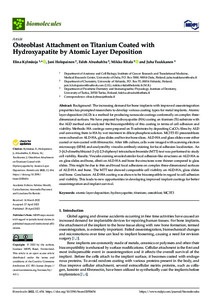Osteoblast Attachment on Titanium Coated with Hydroxyapatite by Atomic Layer Deposition
Kylmäoja Elina; Holopainen Jani; Abushahba Faleh; Ritala Mikko; Tuukkanen Juha
https://urn.fi/URN:NBN:fi-fe2022081154751
Tiivistelmä
Background: The increasing demand for bone implants with improved osseointegration properties has prompted researchers to develop various coating types for metal implants. Atomic layer deposition (ALD) is a method for producing nanoscale coatings conformally on complex three-dimensional surfaces. We have prepared hydroxyapatite (HA) coating on titanium (Ti) substrate with the ALD method and analyzed the biocompatibility of this coating in terms of cell adhesion and viability.
Methods: HA coatings were prepared on Ti substrates by depositing CaCO3 films by ALD and converting them to HA by wet treatment in dilute phosphate solution. MC3T3-E1 preosteoblasts were cultured on ALD-HA, glass slides and bovine bone slices. ALD-HA and glass slides were either coated or non-coated with fibronectin. After 48h culture, cells were imaged with scanning electron microscopy (SEM) and analyzed by vinculin antibody staining for focal adhesion localization. An 3-[4,5-dimethylthiazol-2-yl]-2,5-diphenyl tetrazolium bromide (MTT) test was performed to study cell viability.
Results: Vinculin staining revealed similar focal adhesion-like structures on ALD-HA as on glass slides and bone, albeit on ALD-HA and bone the structures were thinner compared to glass slides. This might be due to thin and broad focal adhesions on complex three-dimensional surfaces of ALD-HA and bone. The MTT test showed comparable cell viability on ALD-HA, glass slides and bone.
Conclusion: ALD-HA coating was shown to be biocompatible in regard to cell adhesion and viability. This leads to new opportunities in developing improved implant coatings for better osseointegration and implant survival.
Kokoelmat
- Rinnakkaistallenteet [27094]
